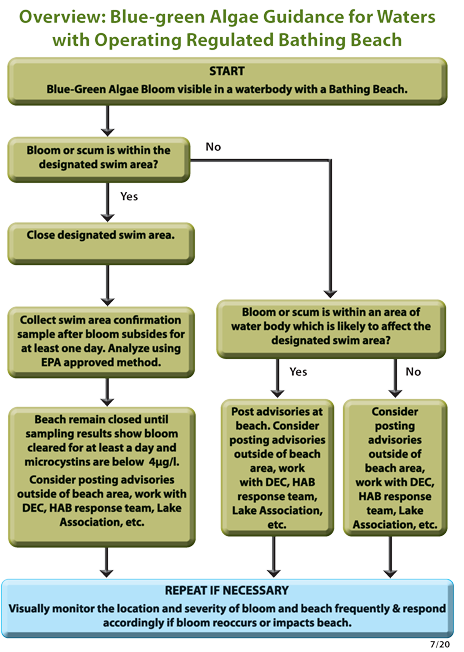Harmful Blue-green Algae Blooms at New York State Regulated Beaches
Translate this page into other languages:
The number of reported harmful blue-green algae blooms in New York State has been increasing each year. In response, swimming areas at regulated beaches are closed more frequently and often for longer periods of time to ensure that people avoid contact with harmful blue-green algae blooms and their toxins.
Harmful blue-green algae are microscopic organisms that can form dense blooms in surface waters. People and animals should avoid blooms because harmful blue-green algae can cause health effects. Some harmful blue-green algae can produce toxins, some do not. Exposure to any harmful blue-green algae can cause health effects in people and animals when water with dense blooms is contacted or swallowed or when airborne droplets are inhaled. When a harmful blue-green algae bloom is present at a beach, the swimming area must be closed to protect public health, regardless if toxins are present.
View Trends in Harmful Blue-green Algae Blooms at Regulated Beaches
- Latest Harmful Blue-green Algae Bloom-related Beach Closure Summary
- Harmful Blue-green Algae Bloom Beach Trends
Bloom Response and Regulated Beaches 
The State Health Department regulates beaches and provides guidance to local health departments and beach operators for responding to harmful blue-green algae blooms. This guidance supports local health departments as they enforce the regulations in the New York State Sanitary Code. The State Health Department also provides advice about actions people should take to avoid exposures to harmful blue-green algae blooms and toxins.
Regulated beaches must be closed for swimming and wading when blooms are observed in the swimming area. Swim areas may not reopen until a bloom is no longer visible for at least one day. The water in the swim area must also be tested to confirm that the level of microcystins is below 4 micrograms per liter before it may reopen, which is below the current health advisory level recommended by the U.S. Environmental Protection Agency. Microcystins are the most commonly-found toxins associated with harmful blue-green algae.
New York State's guidance includes tools for bloom identification, beach closure criteria, sampling and laboratory instructions, beach reopening criteria, event and illness reporting, and signage and public notification templates. Guidance is also provided to help protect people who recreate outside of regulated beaches so that facility and property owners can follow similar steps to recognize harmful blue-green algae blooms and take actions to protect the public from contact with waters containing blooms.
Local health departments oversee compliance with harmful blue-green algae bloom guidance at local regulated beaches. The New York State Department of Environmental Conservation and Office of Parks, Recreation and Historic Preservation also follow this guidance to ensure that consistent actions are taken to close swimming areas and prevent people’s contact with water containing blue-green algae blooms.
Beach operators have been following New York State’s harmful blue-green algae bloom bathing beach guidance since 2010. While harmful blue-green algae blooms have been occurring more frequently and for longer durations at New York State's beaches, the number of harmful blue-green algae-related reported illnesses remains very low due to in part to the responsiveness of beach operators and local officials in following the state's guidance and notifying the public about the importance of keeping people and animals away from any strongly colored water and floating mats and scums.